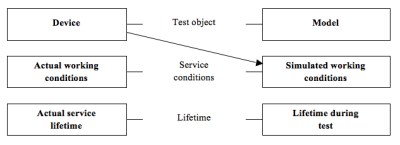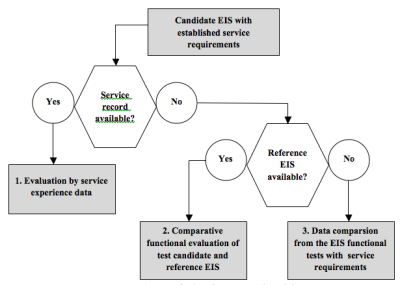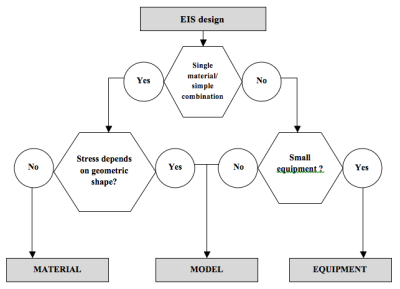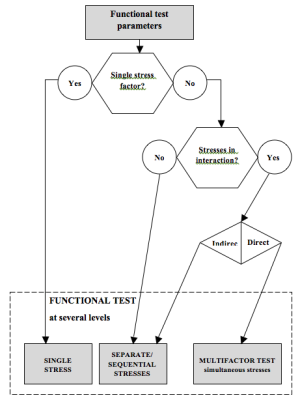The comprehensive assessment of the electrical insulation systems
21. Október, 2013, Autor článku: Váry Michal, Elektrotechnika
Ročník 6, číslo 10  Pridať príspevok
Pridať príspevok
![]() Electrical insulation materials are a part of almost each electrical device. An important problem is the determination of residual life of device often conditional to the electrical insulation lifetime. The main reason for assessment of electrical insulation system is that a possible failure may endanger the operation and safety and cause damage to the device. We start from the assumption that the operation factors cause insulation structure changes and consequent changes in insulation properties.
Electrical insulation materials are a part of almost each electrical device. An important problem is the determination of residual life of device often conditional to the electrical insulation lifetime. The main reason for assessment of electrical insulation system is that a possible failure may endanger the operation and safety and cause damage to the device. We start from the assumption that the operation factors cause insulation structure changes and consequent changes in insulation properties.
So changes are inevitable and its result is time-dependency of investigated properties. To estimate this dependence and behavior of the electrical insulation system in the long-term is necessary to know and define the process on the comprehensive levels. In this contribution we will try to outline the procedures of difficult comprehensive evaluation of electrical insulation system, test objects design and experimental test procedures methods.
1. The degradation processes in the electrical insulation systems
Electrical insulation materials are a part of almost each electrical device. From this perspective is very important to know its properties and parameters not only immediately after manufacture, but also to estimate their future trend. An important problem is the determination of residual life. The main reason for this approach is that a possible failure could endanger the operation and safety and cause damage to the device. On the other hand, replacement is economically costly affair, not to mention the losses incurred by the operating devices shutdown.
Device residual life estimate is therefore important both from of economic as well as from the safety side. We start from the assumption that the service factors cause insulation structure changes and consequent changes in insulation properties. Thus that, changes are inevitable and its result is time-dependency of properties. To estimate this dependence and behavior of the electrical insulation system (EIS), as well as its components, in the long-term is necessary to know and define the process on the difficult – comprehensive levels. Therefore, we need to know [1-5]:
- the factors, mechanisms and the rate of ageing,
- the service conditions,
- the failure mechanisms in the particular conditions,
- the diagnostic methods,
- the limit criteria of changes in the monitored properties.
The degradation factors, which act to the device, are variable and determined by surrounding environment, where device is located. The presence of several factors in the same time can cause a synergistic effect, which may result to amplification or reduction influences acting on device. In the regard to quantity of factors that in the practice may participate on electrical equipment ageing, it is impossible to draw any conclusions that could be applied universally. Therefore it is necessary to approach to the specific problems individually and justify conclusions by experiment.
The procedures, which will be subject to intensive stress to device than in service for the purpose to estimate lifetime, are called accelerated ageing test. By performing the accelerated ageing we can obtain data about material durability and resistance to the action of the service factors in a relatively short time. Correct material assessment methodology of ageing processes is a serious technical problem that requires significant experience in this field. Knowledge of a lifetime, respectively component and whole device endurance against defined internal and external conditions is basic prerequisite for high-quality technical equipment design. Service lifetime is a necessary condition for achieving the required quality and reliability of the product or device in service.
2. The mechanisms and the effects of ageing
The external factors cause changes in the material properties. Firstly there are transient – the reversible changes, but more dangerous are permanent – the irreversible changes, which persist even after the termination of external effect. The reason for permanent changes is the effect of the same factors as in the case of transient factors effect, but permanent changes are usually caused by the greater intensity and longer time exposition of external factors. Permanent changes are not directly a result of external activity, but mostly as a result of internal chemical changes, which are consequences of the effect of external factors to insulation.
Irreversible changes of material properties are almost every time change to the worse, therefore they are called ageing. The effect of some external factors and thus ageing effect is homogenous throughout the material volume. Other factors (such as ultraviolet radiation or ozone exposition) are active mainly on the surface. As a consequence properties changes are the greatest at the surface and inwards weaken. Such types of ageing are referred as corrosion. These effects can cause that the material properties get out of the safe operation range, specified by standards for safe operation. This leads to an increase system crash probability, whether in normal service condition or in the event of failure.
Because the electrical devices as well as EIS are not only used in the areas, where they have been designed, but also in areas with different climatic and service conditions, it is necessary to consider this aspect already in the design procedure. Insulation, which is suitable with the conditions of the local climate, may in fact lose functional ability, if the insulation will be used in areas with different climatic conditions. The main environmental and service effects that cause degeneration are temperature, solar radiation, chemical, mechanical and electrical stresses. For example other factors are exposure to the moisture and water, chemical reagents contained in the atmosphere and the radiation dose. The degeneration rate depends on material properties, given factor exposure time and its intensity. It is necessary to define the mechanisms of ageing and their relevance to the type of equipment or device, in which will be EIS used.
With regard to the issue of low-voltage and high-voltage power cables, generally temperature and electric field intensity are considered as dominant factors causing insulation degradation. Therefore, it is generally paid increased attention to the action of just these two degradation phenomena.
Furthermore, we will carry on a functional assessment of EIS. Preparation of these methods requires careful consideration of methodological elements [5]. The object of the EIS is avilable to as a part of original electric device, or as its part or model (Fig. 1). In general will be beneficial to have maximum technical information about the EIS. Such information may be required, if the model construction of the EIS will be necessary.

Figure 1: Methodological elements of EIS evaluation methods [3]
The electrical equipment service conditions, containing an EIS, should be known and can be available from:
- specified stress data, if new device or EIS are designed for specific service conditions, including surrounding environment and the type of operation,
- records from operation, if the EIS will be evaluated, which was proved in service, levels of stress can be after defined by stress intervals, or by recorded maximum stress limit values relating to the type of operation data, indicating the relationship between stress – time,
- known reference system service conditions, which has been classified on the basis of service records and with which will be the candidate EIS compare for parallel functional tests of comparable or even the same service conditions.
The lifetime values are related to the EIS and to the service conditions. They are the main assessment objectives and must be available as one of the following variants:
- EIS service time to failure (end of life),
- service time without failure,
- EIS lifetime in the functional test to the end-point criteria, with test acceleration or without it.
In the specification process of functional assessment method is necessary to consider the technical inputs and outputs associated with the EIS operation and ageing mechanisms determining the lifetime. The user expects implementing possibility and specified process is to be as simple as possible without neglecting the basic requirements. Economical considerations requires a cost-effective means for solving EIS evaluation tasks for special cases, such as the evaluation of EIS certified in service after small changes using special simplified criteria. Depending on source, from whom necessary evaluating data originates, for candidate EIS there are three different types of evaluation procedures (Fig. 2) [5]:
- For assessment are primarily used service records of service conditions at the service time without failure or time to failure, maintenance results, etc. Operation experiences data have to include all relevant service conditions to which the EIS is exposed. The submission of accurate numerical data is not always possible in practice. In these cases have to be used all available information about the service experiences that provide real relevant aspects evaluation with regard to the limited information. EIS classified on the basis of service records can then serve as a reference EIS for the comparative functional tests.
- This approach is preferred. The candidate and the reference EIS are subjected to an identical or corresponding ageing process. System condition is monitored by equivalent diagnostic tests.
- Without reference EIS and without service experiences is candidate EIS submitted to tests, which verify that EIS corresponds to a well defined group of service requirements. This approach can be used in case of new EIS applications (new EIS, new equipment …). Functional test have to be able to demonstrate the ability to achieve the required EIS lifetime.

Figure 2: Type of EIS evaluation procedures [5]

Figure 3: Choice of test object [5]
3. The test object and experimental test procedures selection
In functional testing – with reference EIS or without it – the test object are subjected to the specified stress programs causing ageing, usually in action of stress cycles, which have to represent ageing processes in service operation. For the purpose of determining the rate of ageing the diagnostic test procedures are used periodically. On the flowchart (Fig. 4) are shown three different types of tests [5]. The criteria are number of ageing factors, test object and possible interactions between the affecting factors.

Figure 4: Establishing the test method [3]
The test objects must be complete units that include EIS, or should be modified to adequately represent configuration of the finished part, which to be in assessment (Fig. 3). Where there the parts, which will use the candidate EIS have mechanical fixations in service, which are supposed to affect the ageing process, these fixations on test object must be simulated. Test object must be designed to withstand the stress levels that can be applied during ageing or during diagnostic sub-cycles.
Where possible, least five samples must be subjected to ageing for each combination of electrical, thermal, mechanical and environmental stresses, or multiple stresses factors, which are included in the assessment program. Visual inspection and all tests to ensure product quality for all test objects before tests have to be performed. Where is necessary, test objects should to be preconditioned in order better represent EIS state in operation. Each test object must be subjected to diagnostic tests chosen for the evaluation process before starting the first ageing cycle.
Functional tests can be carried out as continuous ageing test, if the test end-point criteria are given by time to electrical or mechanical failure or breakdown, either at stress levels causing ageing or at permanently service diagnostic stress. Cyclical lifetime tests consisting of sequence of repeated different ageing sub-cycles and various diagnostic sub-cycles are universally applicable.
Under test stress conditions are necessary to take into consideration the most severe conditions of total stress that occur in service, for which EIS is intended. Reference service conditions for assessment procedure must be clearly defined and the levels and types of diagnostic factors must be applied to these reference working conditions. Ageing sub-cycles stress levels must be chosen so as to ageing mechanisms significantly not different from those, which have occurred in normal operation. Accelerated ageing levels can be allowed unless significantly does not change the ageing mechanism. For acceleration the ageing process in order to shorten test time, stress at elevated levels is applied. The EIS lifetime determined by functional tests – simulating service conditions – represents an estimate-based determined EIS service lifetime.
References
- DENSLEY, J.: Ageing Mechanisms and Diagnostics for Power Cables – An Overview, IEEE Electrical Insulation Magazine, Vol. 17, No. 1, pp. 14-22, January/February 2001.
- LEWIS, T.J.: Ageing – A Perspective, IEEE Electrical Insulation Magazine, Vol. 17, No. 4, pp 6-16, July/August 2001.
- STN EN 60505: Hodnotenie a klasifikácia elektroizolačných systémov. 2012.
- EN 60505 – 1: Evaluation and qualification of electrical insulation systems, Part 1: General, 2000.
- EN 60505 – 2: Evaluation and qualification of electrical insulation systems, Part 2: Thermal, Electrical, Environmental, Mechanical and Multi-Factor; 2000.
Coauthor of this paper is Eduard Firický, IPAEE DMaT FEI STU Bratislava, Ilkovičova 3, 812 19 Bratislava

